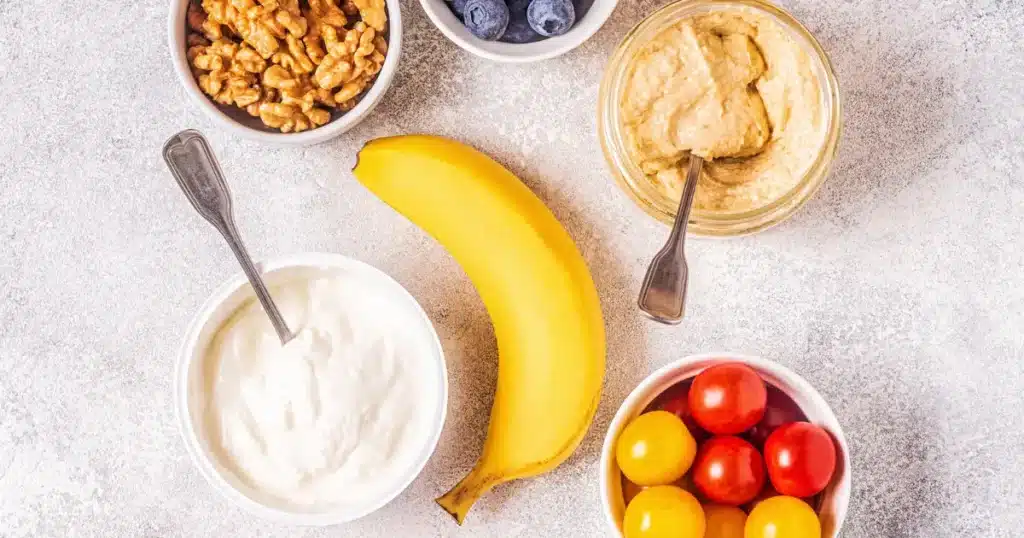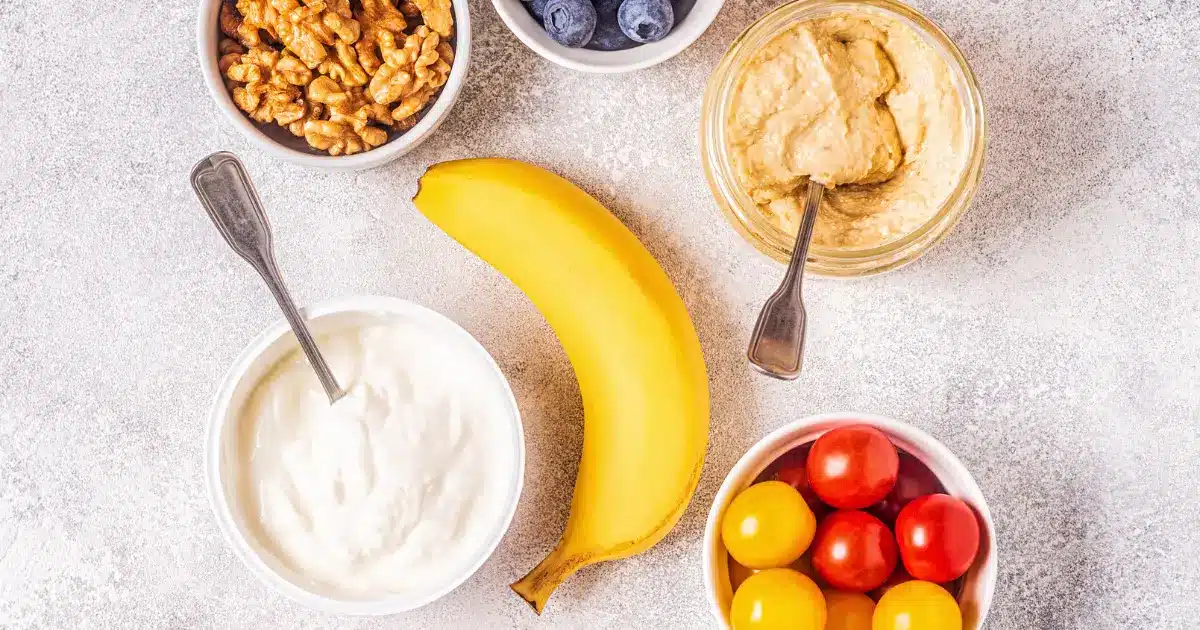RUNNING →
Level Up Your Nutrition Game With Our Freebies
Alex
I provide nutrition coaching for endurance athletes to improve performance and body composition through a simple and flexible eating style.
Hi, I'm
ATHLETE EATING GUIDE →
PROTEIN →
TRIATHLON →
RECIPES →
PERFORMANCE NUTRITION →
SUPPLEMENTS →
HOLIDAY & TRAVEL →
PLANT-BASED →
FEMALE ATHLETE NUTRITION
Explore the Blog
LEARN MORE →
ATHLETE GROCERY SHOPPING GUIDE →
RACE DAY: TRIATHLON NUTRITION PLANNER →
READY TO FUEL?
incredible value!
The fueling guide bundle serves as your one-stop-shop for strategies to fueling before, during and after your workouts.
ENDURANCE EATS
BINGE-WATCH READY!
YOUTUBE SERIES
Recently I was on the phone with a runner – a dad of two young kids – who got me thinking about how as a parent we conveniently always have access to snacks. Let’s take advantage! As a mom and a triathlete I fully understand the challenge of keeping your cupboards stocked with endurance nutrition products, gels, goo, energy bites and waffles, in addition to the snacks for my kids. Here are my top ten favorite snacks for busy athletes!
Now, sports-specific products do have their perks as they’re designed to be energy-dense, quick and easy to consume while on the move (literally), and typically made up of easy-to-digest/absorb sugar/carbs/protein (aka: your stomach tolerates them better). So I’m not saying you should replace these with your family’s fruit snacks. But, if your sports products happen to be out of stock at home and you’re needing to fuel your training workout… I’d head to the cupboard!

Here’s my top picks of easy snacks for busy athletes to use for your endurance fuel:
Pureed fruit squeeze pouches
You know what I’m talking about right? The latest craze in snack packaging. Squeeze pouches. I’ll admit even as a 35 year old, I find eating these fun.
Pros: Delicious. Easy to carry/transport. Easy to eat while on the move. No mess. Tons of flavor options. Can buy in bulk to save $$$.
Cons: Only ~80 calories per pouch which doesn’t get you far, especially for endurance athletes.
Gummy Fruit Snacks
Oh, yes. Those yummy little sugary bites of fruit-flavored deliciousness – conveniently packaged in a travel-friendly plastic pouch.
Pros: Lots of flavor options so you can find one that you like. Great to travel with. Typically heat resistant so won’t melt. Fairly easy to eat while on the move (anything with a wrapper can be challenging on a bicycle pending your bike skills). Buy in bulk to save money. Hellllloooooo, Costco!
Cons: Not as energy dense as sports-specific energy bites. Depending on the size of the package – calorie range is anywhere from 80-150 calories. So may require more time to eat/chew. Usually only one source of sugar in these, versus sports products will have a few sugar sources which can aid in faster digestion/absorption.
Goldfish Crackers
Ok, yes these are marketed to kids – but we all know as parents we snack on them as well. I buy them in the ginormous cardboard container, but if I traveled more with my child I’d definitely buy the travel-sized pouches.
Pros: one travel-sized pouch is 100 calories and is a nice salty, savory flavor (compared to just consuming all things sweet, which can be mentally boring).
Cons: Requires a bit more time to eat.
belVita Breakfast Biscuits
I’m adding these to the list because they are shockingly delicious and make great & easy kid snacks. Great texture and surprisingly filling. I envision enjoying these on really long bike rides where you’re looking for actual food instead of the super sweet gels/goo/bites. I’m a fan of the waffle sports products, and I feel like this would be a great alternative if you don’t have access to the waffles.
Pros: Filling and tasty.
Cons: one biscuit is about 50-60 calories – and one package include 4 biscuits so can get 230 calories total, but will take some time to eat all that. When I eat these I’m always super thirsty afterwards, so you’ll want to have some water nearby when eating. These can be a little bit on the pricey end of the snack spectrum.
Possible cons: They have about 8 g of fat, 4 g protein and 3 g of fiber. Depending on how finicky your stomach is, this could cause a problem. But, this is what also makes them filling. So for cyclists – this may be a great option. Runners with sensitive stomachs – not so much.
Pretzels/Potato Chips
I have a special place in my heart for pretzels and plain potato chips as they are commonly found at the aid stations of 70.3/140.6 distance races and a lot of the organized century bike rides I’ve done in previous years. When you’re outside for hours sweating, a salty snack like pretzels and potato chips taste absolutely amazing. An ounce of plain, hard pretzel twists = about 100 calories and a little over 300 mg of sodium. About 17 plain potato chips = 120 calories and 160 mg sodium.
Pros: Salty, tasty goodness. Also commonly seen out on the endurance race courses so it’s great idea to practice fueling with this during your training so that you know 100% it’s safe to eat during your race. Eating these can be a mood booster as it feels like you’re eating real food.
Cons: Not quick to consume and continue on your way in your workout. If you have a sensitive stomach, these could potentially be a no-no for you. But, again I’d trial it.
Rice Krispies Bars/Treats
I’m talking about the pre-packaged treats here, but not to say you can’t use homemade either. The plain Rice Krispies Treats that come in the .78 oz package are about 90 calories. While their allergen label doesn’t list wheat, I’d confirm with Kellogg’s to make sure they’re gluten-free safe for those with Celiac disease.
Pros: Delicious. Based on the ingredient list these contain a variety of sugar/carb sources via rice cereal, dextrose, corn syrup and fructose. Also offers a small amount of sodium.
Cons: Very chewy. Not the fastest food to chew and consume while exercising, and for long-distance workouts you’ll likely need to fuel with additional sources as 90 calories probably isn’t going to cut it.
Chocolate Milk
Ok, this is more for after your workout, but chocolate milk has a ton of research that supports it being IDEAL for post-workout recovery. The reason why? It hydrates you + offers the ideal 3:1 carb-to-protein ratio – not to mention that milk’s protein quality is top notch with a great source of the amino acid leucine that is needed for the body to start building muscle + offers electrolytes.
Pros: Tastes great. Ideal nutrition for post-workout. Hydrating. Easy to find at nearby gas station/store when traveling. Affordable.
Cons: Needs refrigeration or a cooler to keep cold. Though Fairlife makes some great shelf-table flavored protein beverages that are great for post-workout!
Granola Bars
This is the one that I am going to say tread carefully, cause not all granola bars are created equal.
I would definitely avoid bars that promote high fiber content (such as Fiber One) as they are well-known for causing gas/digestive issues.
Pros: Easy for on-the-go.
Cons: Chewy and take awhile to actually eat. You probably would want to follow it up with some water, which you may or may not always have access to right away. There are a huge varieties of granola bars so unsure as to the nutrition you’d be receiving, would need to read label to make sure it’s a good fit for your needs.
My No-Bake Energy Bite recipe makes a great granola bar alternative too!
String Cheese
I love love string cheese. Ever since I was a kid, I’ve required my refrigerator to be stocked with them. During my IM Wisconsin training I ate a lot of string cheese post-workout as it was easy, quick and gave me six grams of fantastic protein without having to cook anything (which I rarely had the energy to do).
Pros: Great quality protein source. Easy to pair with a carb-rich food. Tasty. Provides salt. Easy to travel/carry.
Cons: Needs refrigeration or a cooler to keep cold.
Snack Crackers/Cookies
So think like Teddy Grahams, Chips Ahoy!, animal crackers, Annie’s snack items. Stay with me here even if you’re thinking, “What the hell? Alex, this is junk food.” Yes, it’s not exactly the healthiest items, but when you’re in a pinch and need some fuel for your workout these items will offer you carbs and some salt – two very important things to refuel with.
Pros: 1 travel-sized pack is about 120-140 calories. Nice travel size packages.
Cons: Definitely not the healthiest. Not the easiest, fastest energy source and you’ll likely want to chase it with some water afterwards.
Have you used easy kid snacks as fuel for your training? Write your favorite in the comment section below!
Alex
I provide nutrition coaching for endurance athletes to improve performance and body composition through a simple and flexible eating style.
Hi, I'm
LEARN MORE →
take the quiz!
Let's discover your Endurance Nutrition IQ
How well do you know your fueling? Answer these questions and let's see where your endurance nutrition knowledge is at!
Take the quiz
Athlete Eating Guide
Athlete Grocery Shopping Guide
Race Day: Triathlon Nutrition Planner
level up your nutrition game with these freebies
free downloadS
1
2
3
Planning what goes on your plate.
Putting the right foods in your grocery cart.
Don't let nutrition derail your race.
